You might not normally think about clams when it comes to your diet – heck, you might never have thought about them before today. I’d like to challenge you to reconsider:
Clams come with a whole host of benefits, they are an environmentally-sound food choice, completely sustainable, low in toxins, high in many hard-to-find nutrients, easy to prepare, and safe for limited diets.
It also helps that, when cooked properly, they are super tasty. Here’s what you need to know about clams, what they provide, and why you might find yourself at the seafood counter of your local grocery store sooner than later…
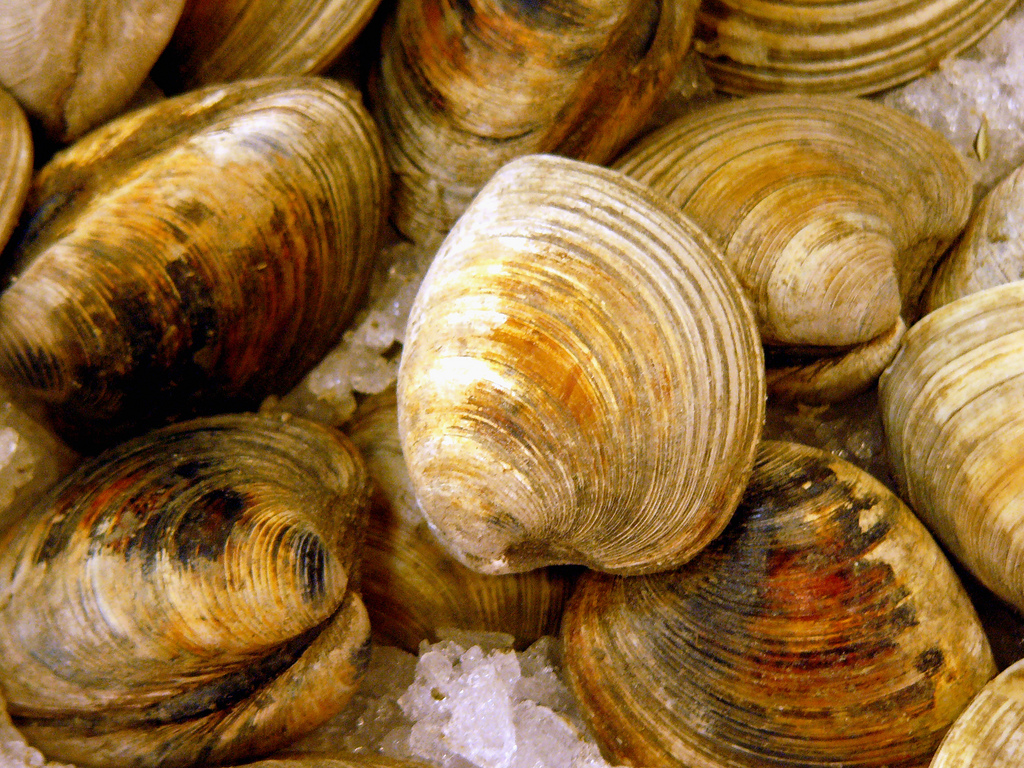
Clams – An Environmentally Conscious Choice
In a recent article that I read, it was argued that clams are one of the most ethical, environmentally-sound seafood choices out there.1 One of the big reasons for this is that clams do not have to be fed living things.
Instead, clams filter their nutrients from the water which surrounds them. Finfish (fish with fins that swim) and crustaceans, like shrimp and lobster, have to eat other fish or fishmeal – clams, on the other hand, filter water and make water safe for other fish (allowing their populations to thrive).
Animal welfare is also less of a concern for clams. They do not migrate or have any space or social requirements. Whether harvested from the wild or grown in aquaculture, their lives remain essentially the same.
One author described the ideal species for aquaculture as such:
“It should be a species group that does not require fish feed, does not require conversion of habitat, does not contribute to pollution, and has very little potential to be invasive. It should consist of animals who are not likely to experience significant pain and suffering in captivity in particular—animals whose health and wellbeing is at least somewhat compatible with industrial methods.”
Bottom Line: It does not take long to realize that clams fit each and every one of these requirements – making them the conscious choice for those who want to make choices based on the future health of the planet.
Sustainable Seafood
The Monterey Bay Aquarium Seafood Watch is considered, by many, as the de facto authority on seafood sustainability. They consider all listed varieties of clams as “Best Choices” or “Good Alternatives.”
These include the following species:
- Blood Clams
- Chinese razor Clams
- Hard Clams
- Japanese Carpet Shell Clams
- Lyrate Hard Clams
- Northern Quahog
- Northern Razor
- Pacific Geoduck
- Pacific Little Neck
- Softshell
- Venus Clams
- Surfclam
- Ocean Quahog
Key Insight: In fact, literally no specific type of clam is considered a poor choice for sustainable seafood – you cannot go wrong!2
Low In Toxicants
Animal foods in general and seafood, in particular, raises many concerns about exposure to unwanted chemicals (Read: The complete guide to testing your body for toxins). Here’s where clams stand on each:
Mercury
Mercury and methylmercury are two of the top concerns surrounding eating seafood. However, clams are considered to be in the lowest mercury category of seafood, and no restrictions are given for clam intake based on mercury exposure.3
Aluminum
It is possible for clams to contain aluminum, based on their sand content. This is a type aluminum called aluminum calcium silicate.
It is a type that is not (under 0.01%) absorbed by the intestinal tract. It is also not considered to be a neurotoxin and does not bioaccumulate. In fact, it is categorized on the Generally Recognized as Safe (GRAS) list of food ingredients.4
Key Insight: The drawback is that sand in clams can interfere with the bioavailability of their iron content. The sand is not within the clams themselves, washing and rinsing them thoroughly can effectively remove it.
Cadmium
Cadmium is a toxic metal found in many foods. It can contribute to risks of:
- Kidney failure
- Bone loss
- Cardiovascular disease
- Many cancers (especially breast cancer)5
Key Insight: Tobacco users and those who are iron deficient are more at risk for cadmium accumulation.
The foods highest in cadmium include:
- Butter
- Ghee6
- Organ meats (like liver)
- Cocoa7
Scallops, when harvested from certain regions (such as the Pacific Northwest) have been found to contain high levels of cadmium. Even when harvested from the same regions, though, cadmium has not been an issue for clams.8
Misc Toxicants
Per heavy metal assays, clams have undetectable or minimal amounts of all metals measured. The following are average values from 74 to 75 samples from a variety of regions.9
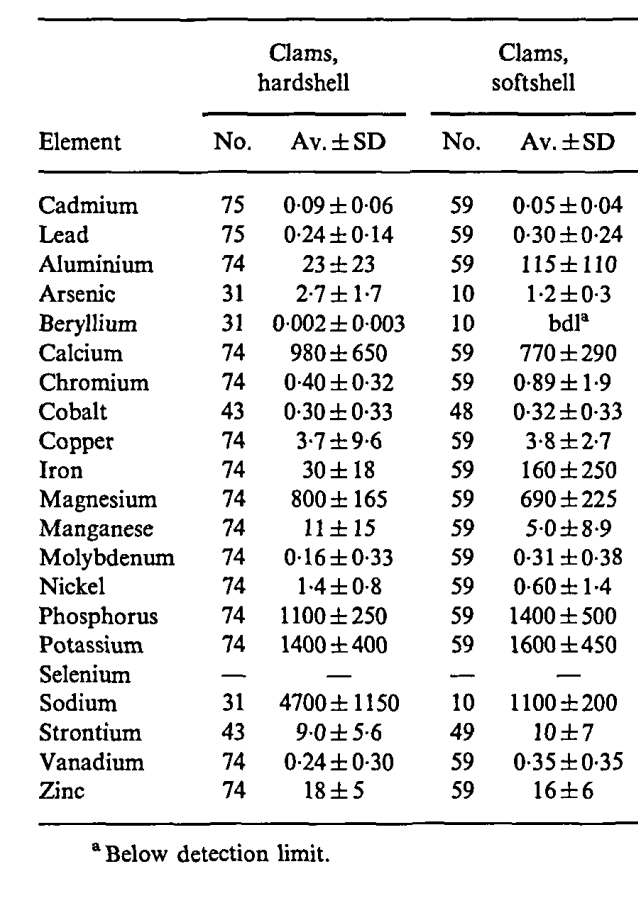
Key Insight: I did find some data that some sources of softshell clams had marginal levels of cadmium. These concerns did not apply to hardshell clams.
Nutrients

Here’s some great news, clams are ridiculously high in lots of essential nutrients! In fact, for the same serving they have:
- 19 times more iron than sirloin steak
- 4.3 times more iron than liver
- 91 times more B12 than sirloin steak
Red meat and liver are often thought of as among the most nutrient-dense foods, but now it might just be time for them to move over and make room for clams!
Here is a side-by-side comparison I put together for you:

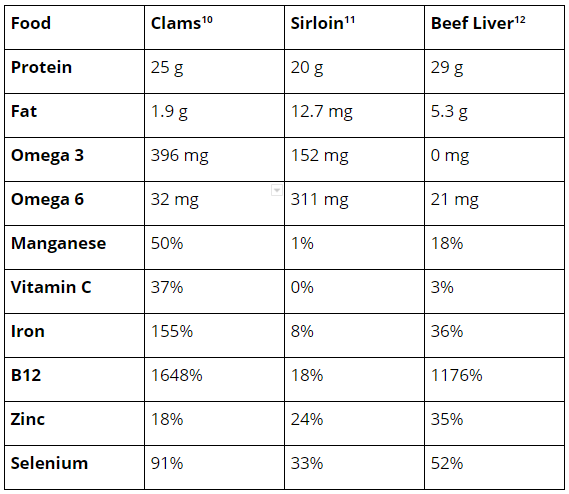
Is the Iron In Clams Bioavailable?
There have been many who have gushed about the high amounts of iron in clams, but it does take some nuance to fully understand.
Key Insight: The labeled amounts do not predict how much iron is available. Live, chopped, or minced clams may have much less bioavailable iron.
f iron is your goal, the best bet is to choose canned whole baby clams. The iron they have is in the amounts listed above, it is heme iron, and is more bioavailable. Also, do make sure to rinse them thoroughly to remove any sand.13
Like other types of seafood, clams are rich in omega-3 fats. Unlike other animal foods, though, clams also have significant amounts of vitamin C which can further aid in their iron absorption.
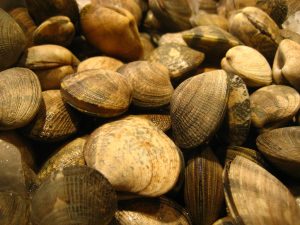
Bottom Line: If you are trying to reverse anemia, clams have more to offer than beef or even liver. Here are some complete nutrient profiles on clams.14
Vitamins In Clams
Along with vitamin C, clams have vitamin A and a good spectrum of B vitamins.
They are also a decent source of choline:

Protein
Protein quality is also excellent in clams. Quality ratings above 100 are considered to be complete.
If you take a look at the comparison between protein quantity, quality, and amino acid content between 100 grams of clams and 100 grams of bone broth.
For comparison purposes, here is the protein breakdown for a 100 gram serving of bone broth:
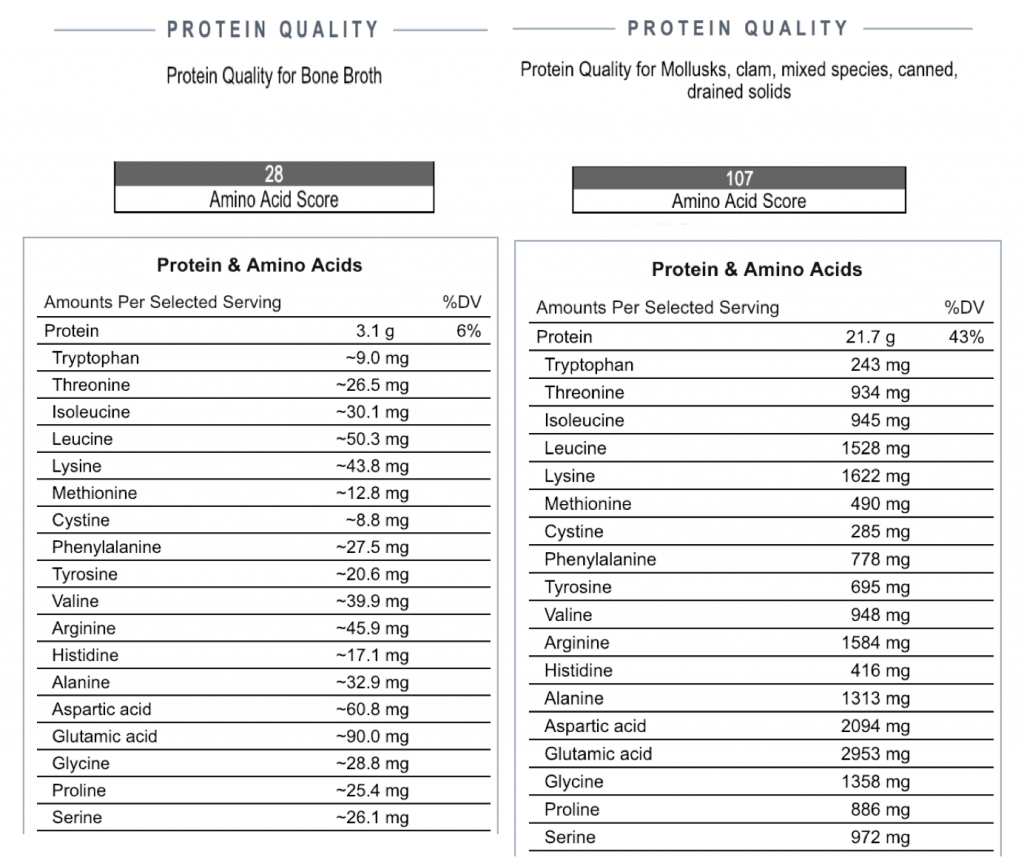
Key Insight: You can see that clams are much higher in essential amino acids and still include glycine, proline, and serine – the sought-after amino acids in bone broth.
Minerals
Iron, zinc, copper, manganese, and selenium – clams are awesome! Thankfully, they are low in fluoride (as high amounts of fluoride can suppress thyroid function).
Clams do contain an average of 66 mcg of iodine per 100 g serving, much less than most types of seafood.15 As such, they can be included in a low-iodine diet as long as other significant sources of iodine are avoided.
Safe for Limited Diets
Most who are vegan avoid animal foods for reasons related to health, ethics, and environmentalism. A subgroup of vegans has examined at these concerns and concluded that none of them apply to bivalves like:
- Clams
- Mussels
- Oysters
The term they have chosen for themselves is Ostrovegan. No, it has nothing to do with ostriches. The prefix ‘ostra-’ refers to oysters or mollusks in general. Ostravegans eat no animal foods (with the exception of bivalves).
Consider the research for their rationale:
“Bivalves [like clams] . . . have a minimal ecological impact while minimizing concerns around welfare in captivity. In fact, bivalves may not just be the best option in the ocean, but the best choice if one chooses to eat animals, period.”16
The argument for health and environmental benefits for eating bivalves over other animal foods are quite clear. Many also feel that bivalves lack the same experiences as more complex animals.
While they do likely have some rudimentary sense of irritation, called nociception, which causes them to move in response to their environments. However, these same properties are found in some plants like Venus flytraps and pitcher plants.
Key Insight: It is clear, though, that they lack elaborate feelings we would call pain, and they almost certainly lack any sense of social bonding or connection.
Nutritionally, clams are a perfect complement to a healthy vegan diet. They fill in gaps surrounding:
- Iron
- B12
- DHA
- Zinc
- High-quality protein
When it comes to those on paleo diets, not only are clams accepted on all versions of the paleo diet, one could argue that clams and shellfish are among the only true “paleo” foods commercially available.
Other animal foods have been hybridized and raised in domestication. Clams are genetically unchanged since well before the days of Paleolithic humans.
This is not true of any other animal or plant food besides other versions of wild seafood. They are also one of the only wild-caught types of animal food available.
Allergies
Most people with allergies to seafood do not have allergies to clams. Those who do have allergies to clams, the reactions tend to be less dangerous than those to shellfish:
“There are two groups of shellfish: crustacea (such as shrimp, crab, and lobster) and mollusks (such as clams, mussels, oysters, and scallops). Crustacea cause most shellfish reactions, and these tend to be severe.”17
Other Considerations
Here’s how clams factor into other diets:
- Goitrogen – Clams have no goitrogenic compounds.
- AIP – Clams are considered safe foods for all versions of the AIP diet.
- Lectins – While I do not subscribe to the belief that lectins in foods commonly eaten pose any harm. Nonetheless, clams are not on “high-lectin” food lists.
- Ketogenic – I also don’t recommend ketogenic diets for general use. However – clams are also keto-friendly.
Bottom Line: How cool is that? Clams are “green-light” food for pretty much everyone. The only reason not to eat them left is that you might not know how to work with them in the kitchen. Let’s take care of that while we’re at it.
Preparing Clams
There are so many options when it comes to preparing clams for consumption. Personally, I have used fresh, frozen, and canned with varying results.
If I lived in the Atlantic Northeast or the Pacific Northwest, I would do the work to get familiar with suppliers of fresh clams. Here in the Sonoran desert, though, my experiences with fresh clams have been hit or miss – even when purchased from reputable supermarkets.
Frozen clams have worked well but can be hard to find. I also did find them hard to get the texture right.
It’s for these reasons that canned clams are my favorite. I know, we often have a visceral reaction against canned food. Some antioxidants in plant foods can be degraded from the high-heat of canning.
Key Insight: These concerns do not apply to seafood. The protein, essential fats, b-vitamins, and minerals are stable throughout canning. Avoid products with colors, preservatives, and cottonseed oil. Also, watch the total added salt content.
If you can find BPA-free cans, that is great! Many companies use BPA-free cans, but do not label their product as BPA-free because of guidelines that allow zero allowable BPA under this claim. Nearly all foods now have measurable amounts of BPA, even if the levels are not significant.18
When I have had clams at restaurants, I would estimate that they included no more than an ounce to an ounce and a half of clams.
Key Insight: If you are using clams to bolster iron and protein, it is best to use a 100 gram (approx 3 ounces) serving size. With a typical 10 ounce can of baby clams, you can get just over two 100-gram servings for $1-2 per serving.
Canned clams are also great because of their shelf life. We love to have a variety of canned seafood like clams, sardines, and oysters on hand to throw together for a last minute meal.

My Favorite Clam Recipes
Canned clams could not be easier to work with. Open the can and rinse the clams thoroughly. If you wish to have clam juice for a recipe, save the liquid.
Here are some of my favorite clams recipes to help you get started…
Linguini and Cherry Tomato Clam Sauce – 4 servings
Ingredients:
- 2 10-ounce cans of whole baby clams, drained and rinsed
- 3 and 1/2 cups of Kirin’s 2-ingredient tomato sauce* or 1 28-ounce can of whole tomatoes, hand crushed
- 6 cloves garlic, peeled and crushed
- 1 tbsp extra virgin olive oil
- 2 tsp Thai fish sauce (can omit or substitute with 1 tbsp nutritional yeast, or 2 anchovies)
- 3 cups spinach leaves
- 1 onion, medium-sized and diced
- 1 shallot, diced
- ½ tsp red pepper flakes
- ½ cup parsley, chopped
- ½ cup white wine
- Linguini pasta
- Regular – I like De Cecco brand best. A serving is only about 1/2 cup cooked
- Gluten-free – my favorite gluten-free linguini is the Barilla brand. There are lots of other good options. Still, only about 1/2 cup cooked per serving.
- Vegetable noodles – You can leave out pasta and just use veggie noodles. Personally, I like to use both so there is more food volume! You can find veggie noodles fresh or frozen in most supermarkets or they are easy to make with a spiralizer. Zucchini is the go-to option.
Directions:
- Prepare pasta as directed.
- Heat olive oil over low-medium heat in a large saucepan.
- Crush garlic and add to olive oil.
- Add spinach, onion, scallion, and red pepper saute until soft.
- Add white wine and clams, sauté for 2 minutes.
- Add all remaining ingredients except parsley.
- Simmer for 30 minutes on low heat.
- Serve over pasta and garnish with parsley
Ostravegan option – substitute nutritional yeast for fish sauce
* Here is how to make Kirin’s 2-ingredient tomato sauce. It is ridiculously good and you won’t believe how easy it is.
Ingredients (You may want to double this if you like more sauce):
- 1/2 an onion – diced
- 4 pint-sized packages cherry tomatoes
Directions:
- Dice onions.
- Slice tomatoes into quarters.
- Using a 1-quart saucepan, saute onions on medium-high heat until they are transparent (about 3 minutes). Stir frequently.
- Add cherry tomatoes to saucepan.
- Reduce to a simmer and stir occasionally for 1 hour. This takes the acid out of the tomatoes and makes it naturally sweet (so you don’t have to add sugar).
Reset Clam Chowder
This is another awesome dish. Great to serve on a cool day. You’ll never even miss the cream. You could substitute other potatoes but russets work best to get the texture right.
Ingredients (4 servings):
- 2 10-ounce cans of whole baby clams, liquid included
- 1 – 8 oz. bottle clam juice
- 1/2 cup vegan bacon bits or 3 strips of turkey bacon
- 2 tsp avocado oil
- 2 stalks celery, chopped
- 1 large onion, chopped
- 3 pounds of russet potatoes (1 and 1/2 pounds diced into 1/2 inch cubes. Remaining potatoes quartered.)
- 5 cloves of garlic cloves
- 1/4 teaspoon red pepper flakes or to taste
- 2 tablespoons of Better Than Bullion vegetable bullion or other vegetable bullion
- 2 bay leaves
- 1/2 tsp each of dried oregano, thyme, and parsley
- 2 cups unsweetened flax milk
Directions:
- Bring 2 quarts of water to a boil in a large saucepan.
- Cook quartered potatoes in boiling water for 12 minutes.
- Remove potatoes from water and set aside. Keep water.
- In a large saucepan, heat 2 tsp of avocado oil over medium heat.
- Add celery, onion, and garlic in that order. Sauteing until each is soft.
- Blend boiled potatoes in a blender with 3 cups of water used for boiling.
- Add blended potatoes into the saucepan with all remaining ingredients except vegan bacon bits.
- Simmer for 30 minutes on low heat.
- Garnish with bacon bits and enjoy!
Resources
1- https://www.treehugger.com/green-food/mussels-clams-and-oysters-are-most-ethical-seafood.html
2 – https://www.seafoodwatch.org/seafood-recommendations/groups/clams
3 – https://www.seafoodhealthfacts.org/seafood-safety/general-information-patients-and-consumers/seafood-safety-topics/mercury-seafood
4 – http://wayback.archive-it.org/7993/20171031063508/https://www.fda.gov/Food/IngredientsPackagingLabeling/GRAS/SCOGS/ucm260849.htm
5 – https://www.ncbi.nlm.nih.gov/pmc/articles/PMC4780235/
6 – https://www.cabdirect.org/cabdirect/abstract/20153427003
7 – https://www.ncbi.nlm.nih.gov/pmc/articles/PMC4780235/
8 – https://sci-hub.tw/10.1080/19440040903367765
9 – https://sci-hub.tw/10.1080/02652039609374440
10 – https://nutritiondata.self.com/facts/finfish-and-shellfish-products/4182/2
11 – https://nutritiondata.self.com/facts/beef-products/3792/2
12 – https://nutritiondata.self.com/facts/beef-products/3469/2
13 – https://www.researchgate.net/publication/229235668_Inconsistent_values_for_iron_content_complicate_recommending_clams_as_an_iron_source
14 – https://nutritiondata.self.com/facts/finfish-and-shellfish-products/4183/2
15 – https://www.ncbi.nlm.nih.gov/pmc/articles/PMC5004500/
16 – https://www.theguardian.com/sustainable-business/2017/jan/23/aquaculture-bivalves-oysters-factory-farming-environment
17 – https://www.foodallergy.org/common-allergens/shellfish-allergy
18 – http://www.crownprince.com/warnings.htm

1. Schedule a Thyroid Second Opinion with me, Dr. C, Click Here for Details
2. Download and use my Favorite Recipes Cookbook Here
3. Check out my podcast Medical Myths, Legends, and Fairytales Here
Dr. Alan Glen Christianson (Dr. C) is a Naturopathic Endocrinologist and the author of The NY Times bestselling Adrenal Reset Diet, The Metabolism Reset Diet and The Thyroid Reset Diet.
Dr. C’s gift for figuring out what really works has helped hundreds of thousands of people reverse thyroid disease, lose weight, diabetes, and regain energy. Learn more about the surprising story that started his quest.


